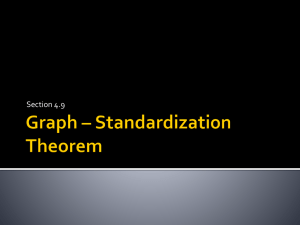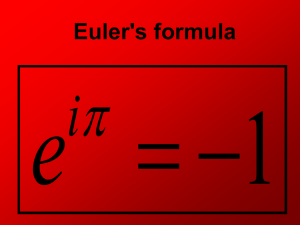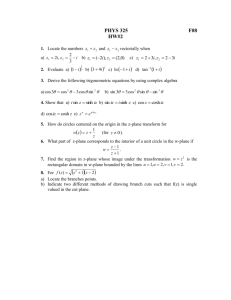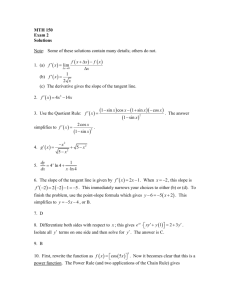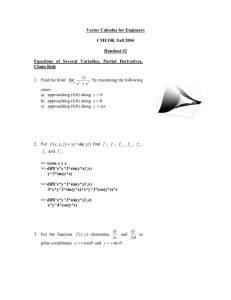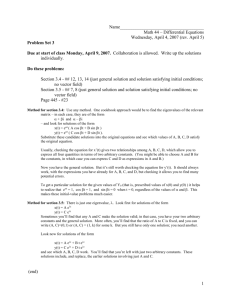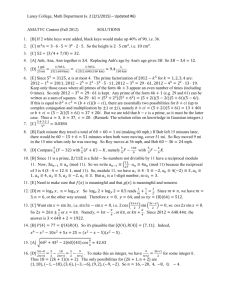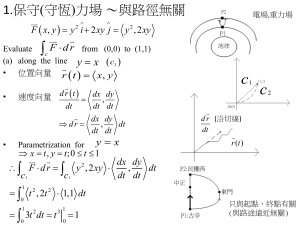Senior Interschool Solutions
advertisement
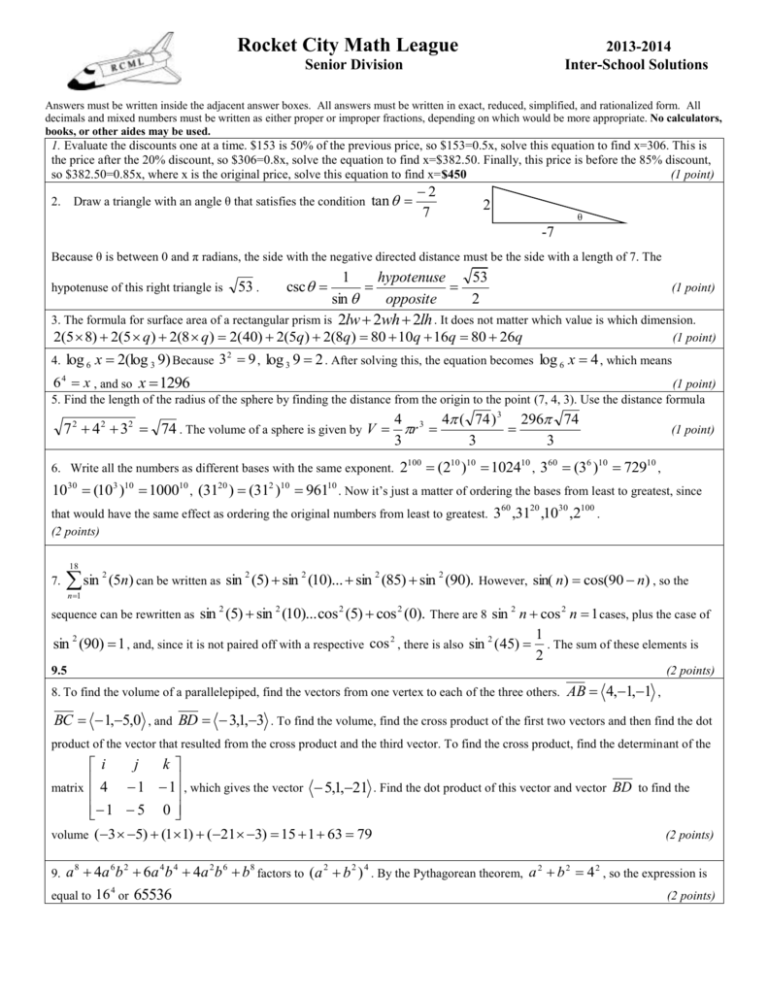
Rocket City Math League 2013-2014 Inter-School Solutions Senior Division Answers must be written inside the adjacent answer boxes. All answers must be written in exact, reduced, simplified, and rationalized form. All decimals and mixed numbers must be written as either proper or improper fractions, depending on which would be more appropriate. No calculators, books, or other aides may be used. 1. Evaluate the discounts one at a time. $153 is 50% of the previous price, so $153=0.5x, solve this equation to find x=306. This is the price after the 20% discount, so $306=0.8x, solve the equation to find x=$382.50. Finally, this price is before the 85% discount, so $382.50=0.85x, where x is the original price, solve this equation to find x=$450 (1 point) Draw a triangle with an angle θ that satisfies the condition tan 2. 2 7 2 θ -7 Because θ is between 0 and π radians, the side with the negative directed distance must be the side with a length of 7. The 1 hypotenuse 53 (1 point) sin opposite 2 3. The formula for surface area of a rectangular prism is 2lw 2wh 2lh . It does not matter which value is which dimension. 2(5 8) 2(5 q) 2(8 q) 2(40) 2(5q) 2(8q) 80 10q 16q 80 26q (1 point) 2 4. log 6 x 2(log 3 9) Because 3 9 , log 3 9 2 . After solving this, the equation becomes log 6 x 4 , which means hypotenuse of this right triangle is 53 . csc 6 4 x , and so x 1296 (1 point) 5. Find the length of the radius of the sphere by finding the distance from the origin to the point (7, 4, 3). Use the distance formula 4 4 ( 74 ) 3 296 74 7 2 42 32 74 . The volume of a sphere is given by V r 3 3 3 3 6. Write all the numbers as different bases with the same exponent. (1 point) 2100 (210 )10 102410 , 360 (36 )10 72910 , 1030 (103 )10 100010 , (3120 ) (312 )10 96110 . Now it’s just a matter of ordering the bases from least to greatest, since that would have the same effect as ordering the original numbers from least to greatest. (2 points) 18 7. sin 2 360 ,3120 ,1030 ,2100 . (5n) can be written as sin 2 (5) sin 2 (10)... sin 2 (85) sin 2 (90). However, sin( n) cos(90 n) , so the n 1 sin 2 (5) sin 2 (10)... cos 2 (5) cos 2 (0). There are 8 sin 2 n cos 2 n 1 cases, plus the case of 1 sin 2 (90) 1 , and, since it is not paired off with a respective cos 2 , there is also sin 2 (45) . The sum of these elements is 2 sequence can be rewritten as 9.5 8. To find the volume of a parallelepiped, find the vectors from one vertex to each of the three others. (2 points) AB 4,1,1 , BC 1,5,0 , and BD 3,1,3 . To find the volume, find the cross product of the first two vectors and then find the dot product of the vector that resulted from the cross product and the third vector. To find the cross product, find the determinant of the j k i 1 1 , which gives the vector 5,1,21 . Find the dot product of this vector and vector BD to find the matrix 4 1 5 0 volume (3 5) (1 1) (21 3) 15 1 63 79 (2 points) a 8 4a 6 b 2 6a 4b 4 4a 2 b 6 b 8 factors to (a 2 b 2 ) 4 . By the Pythagorean theorem, a 2 b 2 4 2 , so the expression is 4 equal to 16 or 65536 (2 points) 9. 10. To begin to decompose the expression into partial fractions, separate the expression into A Bx C , which can be 2 x 5 x 4x 5 thought of as equal to the original expression. Multiply the earlier sum by the denominator of the original fraction, giving A( x 2 4 x 5) ( Bx C )( x 5) for all values of x. 5 A 5C 10 is given when x=0, and when x=5, it is found that A 3 and C 1 . When x=1, it is found that B 2 , so the decomposition of this expression into partial fractions is 3 2x 1 2 x 5 x 4x 5 (3 points) 11. Begin by performing the scalar multiplication on the matrix on the right side of the equal sign. Then, subtract the matrix on the left of the equal sign that is not multiplied by A from the matrix on the right of the equal sign. This should then yield the equation 1 3 4 7 2 5 A 2 2 . Next, find the inverse of the matrix that is being multiplied by A by using the formula 1 d b 1 5 3 5 3 inverse . Next, to find the answer, multiply the inverse by the matrix on the . det c a 1 2 1 2 1 right side of the equal sign, remembering that since matrix multiplication is not commutative, you cannot perform this operation in the other order. 5 3 4 7 14 29 2 1 2 2 6 12 (3 points) 12. Begin by factoring the trinomials in the numerator, which yields factors and multiply by 5 to get y y 5 6( x 7)( x 4)( x 13)( x 5) . Cancel out common 18( x 17)( x 7)( x 4) 2 5( x 13)( x 5) . To find M, set y equal to zero. This means that one of the factors in the 3( x 17)( x 4) numerator must be equal to 0, so the x coordinates of the x-intercepts are 13, -5, and their sum, M=8. The total number of asymptotes, A, can be seen simply by looking at the equation. At x=-17 or x=4, the denominator of the fraction would equal 0, so there is a vertical asymptote at those x values. Because the degree of the numerator and the denominator are the same, there is a 5 , and there is not a slant asymptote. There are 3 total asymptotes, so A=3. R is the y coordinate of the 3 5 y-intercept of any horizontal asymptotes, which have already found. R= . Finally to find S, plug 10 in wherever x appears in the 3 25 5 25 677 equation, which should yield an answer of S= . Finally, make the substitutions and evaluate 8 (3)( ) 54 3 54 54 horizontal asymptote at y= (3 points) 13. Simplify the equation given to (𝑥 − 2)2 + (𝑦 + 2)2 = 10. The center is (2,-2). The radius is 10. Let P (x,y) be a point on the −1 𝑦−8 𝑥−2 circle and Q be (7,8). If ̅̅̅̅ 𝑃𝑄 is tangent to the circle, then 𝑀𝑃𝑄 = , so = −( ). Then, cross multiply to get the equation 𝑀𝑃𝐶 𝑥−7 𝑦+2 𝑥 2 + 𝑦 2 − 9𝑥 − 6𝑦 − 2 = 0 and subtract from the first equation that was given, 𝑥 2 + 𝑦 2 − 4𝑥 + 4𝑦 − 92 = 0 and the difference is −5𝑥 − 10𝑦 + 90 = 0. 𝑥 = 18 − 2𝑦 intersects this line on the original circle at the two points where ̅̅̅̅ 𝑃𝑄 is tangent. Then, find 2 points by squaring the (18 − 2𝑦 − 2)2 + (𝑦 + 2)2 = 100 and solve for y from there. Then, find the x values. You get the points −4 (10, 4) and (2, 8). Find the slope of the lines to find . (4 points) 3 1 3 4 2 1 4 1 ) ( ) 10 For 4 times, it is ( ) 4 ( ) 5 . For 5 times, it is ( ) 5 . 5 5 5 5 5 (160 20 1) 181 Add them all together and you then have , which equals (4 points) 5 3125 5 14. The probability of the event occurring 3 times is ( 15. This problem is best solved geometrically. Construct a square with sides that represent the 11 a.m.- 2 p.m. window during which Juan and Han can arrive at Giacomo’s. For Juan, plot the points (x, y) where x=the time that Juan arrives, and y= the latest that Han can arrive and still eat at the same time as Han, which would be 30 minutes after Juan’s arrival time. Do the same for Han. The resulting figure should look like with the hexagon in the middle representing times that would mean that the two are there at the same time. The probability, P, can be represented as P area (hexagon) . The square has area ( square) sides with length of 180, since there are 180 minutes between 11 a.m. and 2 p.m., and since the window extends 30 minutes wide, the right triangles that represent the space in the square but not inside the hexagon are isosceles with side length 150. Therefore, the area of the hexagon is 180 2 150 2 18000 , so, P 9900 11 32400 36 (5 points) The material on this page is the property of the Rocket City Math League. Reproduction other than for non-profit educational purposes is strictly prohibited without the expressed written consent of the RCML. Rocket City Math League www.rocketcitymath.org Sponsored by Mu Alpha Theta - National Math Honor Society www.mualphatheta.org
